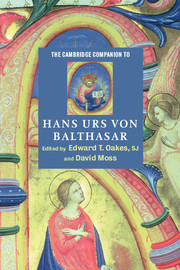Book contents
- Frontmatter
- 1 Introduction
- Part I Theological topics
- 2 Revelation
- 3 Christology
- 4 Balthasar and the Trinity
- 5 For the life of the world: Hans Urs von Balthasar on the Church as Eucharist
- 6 Balthasar and the figure of Mary
- 7 The saints
- 8 One sex or two? Balthasar’s theology of the sexes
- 9 Eschatology
- Part II The trilogy
- Part III Disciplines
- Part IV Contemporary encounters
- Select bibliography
- Index
6 - Balthasar and the figure of Mary
from Part I - Theological topics
Published online by Cambridge University Press: 28 May 2006
- Frontmatter
- 1 Introduction
- Part I Theological topics
- 2 Revelation
- 3 Christology
- 4 Balthasar and the Trinity
- 5 For the life of the world: Hans Urs von Balthasar on the Church as Eucharist
- 6 Balthasar and the figure of Mary
- 7 The saints
- 8 One sex or two? Balthasar’s theology of the sexes
- 9 Eschatology
- Part II The trilogy
- Part III Disciplines
- Part IV Contemporary encounters
- Select bibliography
- Index
Summary
. . . in Mary two things become visible: first, that here is to be found the archetype of a Church that con-forms to Christ, and second, that Christian sanctity is ‘Christ-bearing’, ‘Christophorous’ in essence and actualisation. To the extent that the Church is Marian, she is a pure form which is immediately legible and comprehensible; and to the extent that Christians become Marian (or ‘Christophorous’, which is the same thing), Christ becomes just as simply legible and comprehensible [to the world] in them as well. (GL1, 562)
INTRODUCTION
From the earliest years of Christianity, mention of Mary in the Gospels and creeds has ensured that whenever the Good News of Jesus Christ is proclaimed, the name of his Mother, Mary, has also been heard. For that reason, the earliest doctrinal debates nearly always included reflections upon this woman's significance as part of the early Church's efforts to come to terms with the significance and uniqueness of how God was acting in Christ. But in later Christianity, theology and devotion have not always reflected on the place of Mary when considering the person and work of Christ, with the result that the Blessed Mother began to take on a certain quasi-independent role in Catholic theology while she receded far into the background in Protestant theology and devotion.
- Type
- Chapter
- Information
- The Cambridge Companion to Hans Urs von Balthasar , pp. 64 - 78Publisher: Cambridge University PressPrint publication year: 2004



